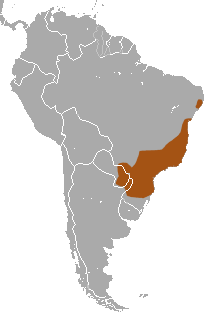Big-eared opossum
| Big-eared opossum[1] | |
|---|---|

| |
| Scientific classification | |
| Domain: | Eukaryota |
| Kingdom: | Animalia |
| Phylum: | Chordata |
| Class: | Mammalia |
| Infraclass: | Marsupialia |
| Order: | Didelphimorphia |
| Family: | Didelphidae |
| Genus: | Didelphis |
| Species: | D. aurita
|
| Binomial name | |
| Didelphis aurita Wied-Neuwied, 1826
| |

| |
| Big-eared opossum range | |
| Synonyms[3] | |
|
List
| |
The big-eared opossum (Didelphis aurita), also known as a saruê,[4][5] or the gambá,[3] is an opossum species from South America. It is found in Argentina, Brazil and Paraguay.[1]
This species, which was considered a population of the common opossum (D. marsupialis) for some time, was originally described as D. azarae by Coenraad Jacob Temminck in 1824, but this name was incorrectly given to the white-eared opossum (D. albiventris) for over 160 years. As such, the name azarae has been abandoned.[1]
Due to carrying offspring, female big-eared opossums tend to stay in smaller areas and reduce their movements.
References
[edit]- ^ a b c Gardner, A.L. (2005). "Order Didelphimorphia". In Wilson, D.E.; Reeder, D.M (eds.). Mammal Species of the World: A Taxonomic and Geographic Reference (3rd ed.). Johns Hopkins University Press. p. 5. ISBN 978-0-8018-8221-0. OCLC 62265494.
- ^ Astua de Moraes, D.; de la Sancha, N.; Costa, L. (2015). "Didelphis aurita". The IUCN Red List of Threatened Species. 2015. IUCN: e.T40500A22175929. doi:10.2305/IUCN.UK.2015-4.RLTS.T40500A22175929.en. Retrieved 19 July 2019.
- ^ a b Gardner, Alfred L. (2007). Mammals of South America Volume 1 Marsupials, Xenarthrans, Shrews, and Bats. Chicago 60637: The University of Chicago Press. ISBN 978-0-226-28240-4.
{{cite book}}: CS1 maint: location (link) - ^ Jane Elizabeth Kraus: FAUNA E FLORA NO CAMPUS: da Cidade Universitária Armando de Salles Oliveira, EDUSP - Editora da Universidade de São Paulo 2005, ISBN 978-85-314-0879-3, p. 124
- ^ Brazil, Tania Kobler (2010). "Didelphis aurita". Catálogo da fauna terrestre de importância médica na Bahia. pp. 191–192. ISBN 978-85-232-1166-0.
External links
[edit]Diogo Loretto, & Marcus Vinícius Vieira. (2005). The Effects of Reproductive and Climatic Seasons on Movements in the Black-Eared Opossum (Didelphis aurita Wied-Neuwied, 1826). Journal of Mammalogy, 86(2), 287–293. http://www.jstor.org/stable/4094347

